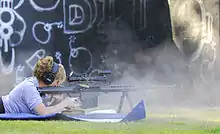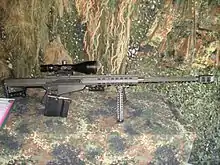Barrett M82
The Barrett M82A1, standardized by the U.S. military as the M107, is a recoil-operated, semi-automatic anti-materiel precision rifle developed by the American Barrett Firearms Manufacturing company. Despite its designation as an anti-materiel rifle, it is used by some armed forces as an anti-personnel system. The M107 variant is also called the Light Fifty for its .50 BMG (12.7×99mm NATO) chambering and significantly lighter weight compared to previous applications and the 15% heavier base M82 model.[1][2] The weapon is found in three variants, the original M82A1 (and A3), the bullpup M82A2 and Barrett M107A1 with muzzle brake designed to accept a suppressor and made out of titanium instead of steel. The M82A2 is no longer manufactured, though the XM500 can be seen as its successor.
| Barrett M82 | |
|---|---|
 The M82A1 | |
| Type | Anti-materiel precision rifle |
| Place of origin | United States |
| Service history | |
| In service | 1989–present |
| Used by | See Users |
| Wars | The Troubles Gulf War War in Afghanistan Iraq War |
| Production history | |
| Designer | Ronnie Barrett |
| Designed | 1980 |
| Manufacturer | Barrett Firearms Manufacturing |
| Unit cost | About $9800 in 2007 $8900 |
| Produced | 1982–present |
| Specifications | |
| Mass | 29.7 lb (13.5 kg) to 30.9 lb (14.0 kg) |
| Length | 48 in (120 cm) to 57 in (140 cm) |
| Barrel length | 20 in (51 cm) to 29 in (74 cm) |
| Cartridge | |
| Action | Recoil-operated rotating bolt |
| Muzzle velocity | 2,799 ft/s (853 m/s) |
| Effective firing range | 1,969 yd (1,800 m) |
| Feed system | 5- or 10-round detachable box magazine |
| Sights | MIL-STD-1913 rail |
Overview
Barrett Firearms Manufacturing was founded by Ronnie Barrett for the sole purpose of building semi-automatic rifles chambered for the powerful 12.7×99mm NATO (.50 BMG) ammunition, originally developed for and used in M2 Browning machine guns. The weapon was first sold to the Swedish Army in 1989. In 1990, the United States armed forces purchased the M82A1 during operations Desert Shield and Desert Storm in Kuwait and Iraq. About 125 rifles were initially bought by the United States Marine Corps, and orders from the Army and Air Force soon followed. The M82A1 is known by the US military as the SASR—"Special Applications Scoped Rifle", and it was and still is used as an anti-materiel rifle and explosive ordnance disposal tool.

In 2006, Barrett completed development of the XM500, which has a bullpup configuration similar to the M82A2. Barrett M82 rifles were bought by various military and police forces from at least 30 countries, such as Belgium, Chile, Denmark, Finland, France, Germany, Greece, Indonesia, Italy, Jamaica, Mexico, the Netherlands,[3] and others.
The Barrett M82A1 rifle was used in 2002 as a platform for the experimental OSW (Objective Sniper Weapon) prototype. This weapon was fitted with a shorter barrel, and fired 25mm high-explosive shells developed for the 25×59 mm OCSW (Objective Crew Served Weapon) automatic grenade launcher. The experimental OSW showed an increased effectiveness against various targets, but the recoil was beyond human limitations. This weapon, also known as the Barrett "Payload Rifle", has now been designated the XM109.
Use by the Provisional IRA
The Provisional IRA smuggled a number of M82s into Ireland from the United States in the 1980s, apparently made and sold by a gunsmith and former Barret Firearms employee in Texas. One of the M82s was shipped from Chicago to Dublin in pieces, where it was re-assembled.[4] The IRA equipped two sniper teams with the light-fifties,[5] later reinforced with a couple of M90s bought in the United States from an arms dealer in 1995.[6] The IRA snipers killed five soldiers and a constable with .50 rifles from 1992 to 1997.[7] The snipers usually fired on their targets from a distance of less than 300 metres, despite the 1,800 meters effective range of the weapons.[8]
M82 to M107

The XM107 was originally intended to be a bolt-action sniper rifle, and the rifle Barrett M95 was originally selected by the U.S. Army in a competition between such weapons. However, under the trials, the decision was made that the U.S. Army did not, in fact, require such a weapon.
Then the Army decided on the Barrett M82, a semi-automatic rifle. In summer 2002, the M82 finally emerged from its Army trial phase and was approved for "full materiel release", meaning it was officially adopted as the Long Range Sniper Rifle, Caliber .50, M107. The M107 uses a Leupold 4.5–14×50 Mark 4 scope.
The Barrett M107 is a .50 caliber, shoulder-fired, semi-automatic sniper rifle. Like its predecessors, the rifle is said to have manageable recoil for a weapon of its size owing to the barrel assembly that itself absorbs force, moving inward toward the receiver against large springs with every shot. Additionally, the weapon's weight and large muzzle brake also assist in recoil reduction. Various changes were made to the original M82A1 to create the M107, with new features such as a lengthened accessory rail, rear grip, and monopod socket. Barrett has recently been asked to develop a lightweight version of the M107 under the Anti-Materiel Sniper Rifle Congressional Program, and has already come up with a scheme to build important component parts such as the receiver frame and muzzle brake out of lighter-weight materials.
The Barrett M107, like previous members of the M82 line, is also referred to as the Barrett "Light Fifty". The designation has in many instances supplanted earlier ones, with the M107 being voted one of 2005's top 10 military inventions by the U.S. Army.[9]
The U.S. Army and Marine Corps plan to field another Barrett rifle, the Mk22 MRAD, in 2021 to replace the M107. The Mk22 is a bolt-action multi-caliber rifle that is powerful enough to replace the M107 when chambered in .338 Norma Magnum.[10]
Technical description




The M82 is a short-recoil semi-automatic firearm. When the gun is fired, the barrel initially recoils for a short distance (about 1 in (25 mm)), while being securely locked by the rotating bolt. After the short travel, the lower part of accelerator arm, held by receiver upper part, is already hinged in bolt carrier and the middle portion strikes it back to the barrel by a rod place in bolt carrier, transferring part of the recoil energy of the barrel to the bolt to achieve reliable cycling and unlock it from barrel. The bolt is unlocked by turning in the curved cam track in the bolt carrier. Then, the barrel is stopped by the combined effect of the accelerator, buffer spring and the muzzle brake and the bolt continues back, to extract and eject a spent case. On its return stroke, the bolt strips the fresh cartridge from the box magazine and feeds it into the chamber and finally locks itself to the barrel. The striker is also cocked on the return stroke of the bolt. The gun is fed from a large, detachable box magazine holding up to 10 rounds, although a rare 12-round magazine was developed for use during Operation Desert Storm in 1991.
The receiver is made from two parts (upper and lower), stamped from sheet steel and connected by cross-pins. The heavy barrel is fluted to improve heat dissipation and save weight, and fitted with a large and effective reactive muzzle brake. On the earlier models, the muzzle brakes had a round cross-section; later M82 rifles are equipped with two-chamber brakes of rectangular cross-section.
M82A1 rifles are fitted with scope mount and folding backup iron sights, should the glass scope break. The U.S. military M82 rifles are often equipped with Leupold Mark 4 telescopic sights. The M82A1M (USMC M82A3) rifles have long Picatinny accessory rails mounted and US Optics telescopic sights. Every M82 rifle is equipped with a folding carrying handle and a folding bipod (both are detachable on the M82A3). The M82A3 is also fitted with a detachable rear monopod under the butt. The buttpad is fitted with a soft recoil pad to further decrease the felt recoil. M82A1 and M82A3 rifles could be mounted on the M3 or M122 infantry tripods (originally intended for machine guns) or on vehicles using the special Barrett soft-mount. The M82A1 can be fitted with a carry sling, but according to those who carried it in the field, the M82 is too uncomfortable to be carried on a sling due to its excessive length and weight. It is usually carried in a special carry soft or hard case.
The M82A2 differed from M82A1 mostly in its configuration; the pistol grip along with trigger was placed ahead of the magazine, and the buttpad placed below the receiver, just after the magazine. An additional forward grip was added below the receiver, and the scope mount was moved forward.
The maximum effective range of the M107 is 2,000 yards (1,830 m). The maximum range of this weapon (specifically the M107 variant) is 4,400 yards (4,000 m), as quoted in the owner's manual. Fifty caliber (and larger) rounds have the potential to travel great distances if fired in an artillery-like fashion (with a high angle, which creates an indirect-fire situation), necessitating the observance of large safety margins when firing on a range.
Users


 Algeria: Used by the Algerian Special Forces.
Algeria: Used by the Algerian Special Forces..svg.png.webp) Australia: Australian Army.[12]
Australia: Australian Army.[12] Austria: Used by Austrian Army SF Jagdkommando.[13]
Austria: Used by Austrian Army SF Jagdkommando.[13] Bangladesh: Used by Black Eagle Sniper Team.
Bangladesh: Used by Black Eagle Sniper Team. Bahrain[14]
Bahrain[14].svg.png.webp) Belgium[14]
Belgium[14] Bhutan[14]
Bhutan[14] Botswana[14]
Botswana[14] Brazil[14]
Brazil[14].svg.png.webp) Canada:[14] Used by JTF2 operatives in small numbers.
Canada:[14] Used by JTF2 operatives in small numbers. Chile[14]
Chile[14] Croatia[14]
Croatia[14] Czech Republic[14][15]
Czech Republic[14][15] Denmark[14]
Denmark[14] Egypt[14] Used by Thunderbolt Forces, Unit 999, Egyptian navy special forces brigades and Black Cobra Unit
Egypt[14] Used by Thunderbolt Forces, Unit 999, Egyptian navy special forces brigades and Black Cobra Unit El Salvador[14]
El Salvador[14] Finland[14]
Finland[14] France[14] Used by GIGN (before PGM Hécate II)
France[14] Used by GIGN (before PGM Hécate II) Georgia: Used by the army including special forces.[16][17]
Georgia: Used by the army including special forces.[16][17] Germany: The M107 is used and designated G82 in the German Army and the M107A1 is used under the designation G82A1.[18]
Germany: The M107 is used and designated G82 in the German Army and the M107A1 is used under the designation G82A1.[18] Greece[14]
Greece[14] India: The M107 is used by Mumbai Police Force One Commandos.[19] Indian special forces use the M107A1.[20]
India: The M107 is used by Mumbai Police Force One Commandos.[19] Indian special forces use the M107A1.[20] Indonesia: The M82A1 Is Used By Komando Pasukan Khusus.[21]
Indonesia: The M82A1 Is Used By Komando Pasukan Khusus.[21] Israel: Used by the IDF Combat Engineering Corps[22]
Israel: Used by the IDF Combat Engineering Corps[22] Italy[14]
Italy[14] Jordan[14][23]
Jordan[14][23] Kuwait[14]
Kuwait[14] Lebanon[24] The Barrett is mostly used by the Lebanese Commando Regiment and the Internal Security Forces.
Lebanon[24] The Barrett is mostly used by the Lebanese Commando Regiment and the Internal Security Forces. Lithuania: Lithuanian Armed Forces.[25]
Lithuania: Lithuanian Armed Forces.[25] Malaysia: Malaysian Special Operations Force.[26]
Malaysia: Malaysian Special Operations Force.[26] Mexico[14]
Mexico[14] Netherlands[14]
Netherlands[14]

 New Zealand: M107A1 to be introduced in 2018 [27]
New Zealand: M107A1 to be introduced in 2018 [27] Norway[14]
Norway[14] Oman[14]
Oman[14] Philippines[14]Armed Forces of the Philippines, Philippine National Police
Philippines[14]Armed Forces of the Philippines, Philippine National Police Poland: Wojska Specjalne
Poland: Wojska Specjalne Portugal[14]
Portugal[14] Qatar[14]
Qatar[14] Saudi Arabia[14]
Saudi Arabia[14] Serbia: Used by the Special Forces.[28][29][30]
Serbia: Used by the Special Forces.[28][29][30] Singapore[14] Used by Special Forces
Singapore[14] Used by Special Forces Slovakia used by 5th Special Operations Regiment[31]
Slovakia used by 5th Special Operations Regiment[31] Slovenia[14] Used by Special Police Unit
Slovenia[14] Used by Special Police Unit Spain[14]
Spain[14] Sweden: Used as Ag 90 C.[14]
Sweden: Used as Ag 90 C.[14] South Korea[32]
South Korea[32] Turkey[14]
Turkey[14] Taiwan[33]
Taiwan[33] Thailand[14]
Thailand[14] Ukraine: In December 2017 US state department approved a license for the $41.5 million commercial sale of .50 caliber Barrett M107A1 sniper rifles and ammunition for use by the Ukrainian army.[34]
Ukraine: In December 2017 US state department approved a license for the $41.5 million commercial sale of .50 caliber Barrett M107A1 sniper rifles and ammunition for use by the Ukrainian army.[34] United Arab Emirates[14]
United Arab Emirates[14] United Kingdom[14]
United Kingdom[14] United States[14]
United States[14] Yemen[35]
Yemen[35]
Awards and recognition
On February 26, 2016, Tennessee named the Barrett Model M82 as its official state rifle.[36][37][38][39]
See also
- Accuracy International AS50
- Raufoss Mk 211 round
- Barrett M90
- Barrett M95
- Barrett XM109
- Boys anti-tank rifle – A British anti-tank rifle in use during the Second World War., a World War II predecessor
- CheyTac Intervention
- MACS M3
- Denel NTW-20 – A South African anti-material rifle
- DSR-50
- PDSHP
- Istiglal anti-materiel rifle
- KSVK 12.7
- List of crew served weapons of the US Armed Forces
- List of individual weapons of the U.S. Armed Forces
- PGM Hécate II
- M24 – Bolt action sniper rifle
- McMillan Tac-50
- OSV-96, a Russian counterpart
- RT-20 (rifle)
- South Armagh Sniper (1990–97)
- Steyr HS .50
References
- "Model 82A1® - Barrett". barrett.net. Archived from the original on 2018-10-18. Retrieved 2018-10-17.
- "M107A1® - Barrett". barrett.net. Archived from the original on 2018-09-20. Retrieved 2018-10-17.
- The weapon is in use by Dutch marines, as part of ISAF.Bemmel, Noël van (2009-08-11). "Met aangepaste Vikings en een reuzengeweer de Chora-vallei in". de Volkskrant. Archived from the original on 2009-08-15. Retrieved 2009-08-13.
- Harnden, Toby (2000). Bandit Country: The IRA and South Armagh. London: Coronet Books. pp. 372 and 392. ISBN 0-340-71737-8.
- Harnden (2000), p. 400
- Harnden (2000), p. 392
- Harnden (2000), pp. 502-505
- Harnden (2000), p. 403
- Police Precision Rifle Press Releases Archived October 14, 2007, at the Wayback Machine.
- Army and Marines to Arm Snipers with Special Operations Multi-Caliber Sniper Rifle. Military.com. 3 March 2020.
- "Telescopic Sights 6–24 x 56; 6–24 x 72" (PDF). Carl Zeiss Optronics. Carl Zeiss AG. Archived from the original (PDF) on 2008-10-31.
- "Uruzgan Provincial Response Company and Australian Special Forces hit insurgents hard". Archived from the original on 2013-07-20. Retrieved 2011-04-22.
- "50 JAHRE JAGDKOMMANDO - DOPPELADLER.COM". www.doppeladler.com. Archived from the original on 2015-09-07. Retrieved 2013-09-03.
- Gander, Terry (2006). Jane's Infantry Weapons 2006–2007. London: Jane's Information Group. p. 22. ISBN 978-0-7106-2755-1.
- Ruční Zbraně AČR Archived 2012-02-29 at the Wayback Machine (in Czech). Ministerstvo obrany České republiky – AVIS, 2007. pp. 70–73. ISBN 978-80-7278-388-5. Accessed April 5, 2010.
- Disarmament.un.org
- "Georgian Army". Georgian Army. Archived from the original on 2012-03-09. Retrieved 2007-06-25.
- Redaktion Heer. Scharfschützengewehr G82 Archived February 17, 2010, at the Wayback Machine (in German). Deutsches Heer, 30 July 2007. Accessed April 5, 2010.
- Swami, Praveen (April 8, 2009). "Mumbai Police modernisation generates controversy". The Hindu. p. 1 ("front page"). Archived from the original on November 8, 2012. Retrieved April 5, 2010.
- Sandeep Unnithan (July 20, 2020). "New tools for India's special forces". India Today. Retrieved 8 August 2020.
- http://www.indomiliter.com/barret-m82a1-kenyang-pengalaman-tempur-dipercaya-kopassus-sebagai-senapan-anti-material/ Archived 2016-01-30 at the Wayback Machine - indomiliter.com, 15 June 2015
- The Engineering Corps Prepares for 2011 Archived January 28, 2011, at the Wayback Machine. IDF Spokesperson, 25 January 2011.
- Shea, Dan (Spring 2009). "SOFEX 2008". Small Arms Defense Journal, p. 29.
- Kahwaji, Riad (November 13, 2007). "Lebanon: Foreign Arms Vital to Hizbollah Fight". Defense News. Archived from the original on July 17, 2011. Retrieved December 15, 2009.
- "Stambaus kalibro snaiperio šautuvas BARRETT 82 A-1" (in Lithuanian). Lithuanian Armed Forces. Archived from the original on 28 July 2010. Retrieved August 2, 2010.
- Thompson, Leroy (December 2008). "Malaysian Special Forces". Special Weapons. Archived from the original on 2012-02-19. Retrieved 2010-02-10.
- Force, New Zealand Defence (18 October 2017). "Defence Force buying two new weapons". Archived from the original on 18 October 2017. Retrieved 18 October 2017.
- "Specijalne-jedinice.com - Antimaterijalne puške "Barrett"". specijalne-jedinice.com. Archived from the original on 2017-02-02. Retrieved 2017-01-25.
- Противтерористичка јединица-ПТЈ (4 February 2013). "PTJ snajperski par Barrett M82A1 call. 50 BMG". Archived from the original on 5 February 2017. Retrieved 25 January 2017 – via YouTube.
- "Archived copy". Archived from the original on 2017-02-02. Retrieved 2017-01-25.CS1 maint: archived copy as title (link)
- http://www.special-ops.pl/artykul/id326,5-psu-gabcikowcy?print=1%7Ctitle= výbava členov 5 PŠU (in Polish language)
- 군사세계. "유용원군사세계 - bemil.com". bemil.chosun.com. Archived from the original on 2014-07-20. Retrieved 2014-07-15.
- HF3A (21 October 2008). "國軍狙擊手VS巴瑞特M107(一)Taiwan-Sniper". Archived from the original on 1 August 2016. Retrieved 29 November 2016 – via YouTube.
- Donald Trump approves deal for US to sell sniper rifles to Ukraine, angering Russia Archived 2018-04-20 at the Wayback Machine, telegraph.co.uk (21 December 2017)
- "North American anti-materiel rifles with Houthi forces in Yemen". The Hoplite. November 19, 2015. Archived from the original on September 12, 2018. Retrieved September 12, 2018.
- Van Huss, James (Micah) (February 26, 2016). "HJR0231" (PDF). Tennessee General Assembly. Archived (PDF) from the original on January 12, 2016.
- Stockard, Sam (24 February 2016). "Rutherford County home to official state firearm". The Murfreesboro Post. Murfreesboro, Tennessee. Archived from the original on 13 March 2016. Retrieved 12 March 2016.
The Barrett .50 resolution passed the House in 2015 sponsored by Rep. Micah Van Huss, R-Johnson City, a former Marine who carried it while serving in Iraq from 2006 to 2010.
- Sher, Andy (24 February 2016). "Tennessee names the Barrett .50 caliber as the state's official rifle". Chattanooga Times Free Press. Archived from the original on 9 March 2016. Retrieved 12 March 2016.
Senate Democratic Caucus Chairman Jeff Yarbro of Nashville cast the lone dissenting vote against making the Barrett rifle the state's official gun.
- Smith, Aaron (26 February 2016). "Tennessee names .50 caliber Barrett as the state rifle". CNNMoney. Archived from the original on 13 March 2016. Retrieved 12 March 2016.
External links
| Wikimedia Commons has media related to M82 (rifle). |
- Barrett's page on the M82A1
- M82A1 Operators Manual
- PEO Soldier M107 fact sheet
- Detailed M107 page including gallery
- M107A1 Sales Sheet
- Globalsecurity.com M82 info with video of effects on steel plating and cinder blocks
- The Barrett M82 from Mel's SniperCentral
- Modern Firearms
- M82 Info from Armedforces-int.com

